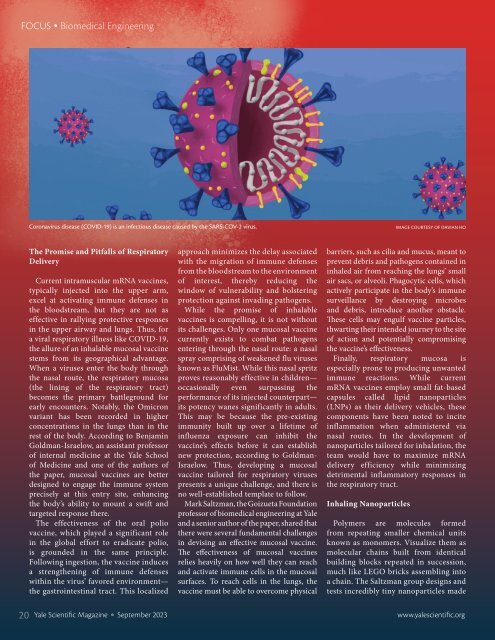YSM Issue 96.3
You also want an ePaper? Increase the reach of your titles
YUMPU automatically turns print PDFs into web optimized ePapers that Google loves.
FOCUS<br />
Biomedical Engineering<br />
Coronavirus disease (COVID-19) is an infectious disease caused by the SARS-COV-2 virus.<br />
IMAGE COURTESY OF DAVIAN HO<br />
The Promise and Pitfalls of Respiratory<br />
Delivery<br />
Current intramuscular mRNA vaccines,<br />
typically injected into the upper arm,<br />
excel at activating immune defenses in<br />
the bloodstream, but they are not as<br />
effective in rallying protective responses<br />
in the upper airway and lungs. Thus, for<br />
a viral respiratory illness like COVID-19,<br />
the allure of an inhalable mucosal vaccine<br />
stems from its geographical advantage.<br />
When a viruses enter the body through<br />
the nasal route, the respiratory mucosa<br />
(the lining of the respiratory tract)<br />
becomes the primary battleground for<br />
early encounters. Notably, the Omicron<br />
variant has been recorded in higher<br />
concentrations in the lungs than in the<br />
rest of the body. According to Benjamin<br />
Goldman-Israelow, an assistant professor<br />
of internal medicine at the Yale School<br />
of Medicine and one of the authors of<br />
the paper, mucosal vaccines are better<br />
designed to engage the immune system<br />
precisely at this entry site, enhancing<br />
the body’s ability to mount a swift and<br />
targeted response there.<br />
The effectiveness of the oral polio<br />
vaccine, which played a significant role<br />
in the global effort to eradicate polio,<br />
is grounded in the same principle.<br />
Following ingestion, the vaccine induces<br />
a strengthening of immune defenses<br />
within the virus’ favored environment—<br />
the gastrointestinal tract. This localized<br />
approach minimizes the delay associated<br />
with the migration of immune defenses<br />
from the bloodstream to the environment<br />
of interest, thereby reducing the<br />
window of vulnerability and bolstering<br />
protection against invading pathogens.<br />
While the promise of inhalable<br />
vaccines is compelling, it is not without<br />
its challenges. Only one mucosal vaccine<br />
currently exists to combat pathogens<br />
entering through the nasal route: a nasal<br />
spray comprising of weakened flu viruses<br />
known as FluMist. While this nasal spritz<br />
proves reasonably effective in children—<br />
occasionally even surpassing the<br />
performance of its injected counterpart—<br />
its potency wanes significantly in adults.<br />
This may be because the pre-existing<br />
immunity built up over a lifetime of<br />
influenza exposure can inhibit the<br />
vaccine’s effects before it can establish<br />
new protection, according to Goldman-<br />
Israelow. Thus, developing a mucosal<br />
vaccine tailored for respiratory viruses<br />
presents a unique challenge, and there is<br />
no well-established template to follow.<br />
Mark Saltzman, the Goizueta Foundation<br />
professor of biomedical engineering at Yale<br />
and a senior author of the paper, shared that<br />
there were several fundamental challenges<br />
in devising an effective mucosal vaccine.<br />
The effectiveness of mucosal vaccines<br />
relies heavily on how well they can reach<br />
and activate immune cells in the mucosal<br />
surfaces. To reach cells in the lungs, the<br />
vaccine must be able to overcome physical<br />
barriers, such as cilia and mucus, meant to<br />
prevent debris and pathogens contained in<br />
inhaled air from reaching the lungs’ small<br />
air sacs, or alveoli. Phagocytic cells, which<br />
actively participate in the body’s immune<br />
surveillance by destroying microbes<br />
and debris, introduce another obstacle.<br />
These cells may engulf vaccine particles,<br />
thwarting their intended journey to the site<br />
of action and potentially compromising<br />
the vaccine’s effectiveness.<br />
Finally, respiratory mucosa is<br />
especially prone to producing unwanted<br />
immune reactions. While current<br />
mRNA vaccines employ small fat-based<br />
capsules called lipid nanoparticles<br />
(LNPs) as their delivery vehicles, these<br />
components have been noted to incite<br />
inflammation when administered via<br />
nasal routes. In the development of<br />
nanoparticles tailored for inhalation, the<br />
team would have to maximize mRNA<br />
delivery efficiency while minimizing<br />
detrimental inflammatory responses in<br />
the respiratory tract.<br />
Inhaling Nanoparticles<br />
Polymers are molecules formed<br />
from repeating smaller chemical units<br />
known as monomers. Visualize them as<br />
molecular chains built from identical<br />
building blocks repeated in succession,<br />
much like LEGO bricks assembling into<br />
a chain. The Saltzman group designs and<br />
tests incredibly tiny nanoparticles made<br />
20 Yale Scientific Magazine September 2023 www.yalescientific.org

















